Cedar Waxwings at the Manasquan Reservoir Environmental Center
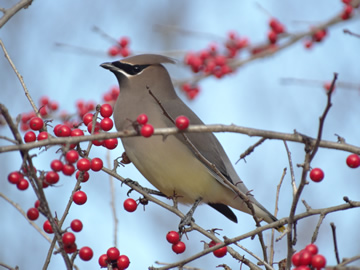
Cedar Waxwings - photo by Aubrey Merrill
Cedar waxwings have been seen filling up on the winterberry holly berries at the Manasquan Reservoir Environmental Center. The name “waxwing” comes from the waxy red secretions found on the tips of their secondary feathers. These birds are present year-round in New Jersey and are one of the few North American birds to specialize in eating fruit. If you want to attract them to your yard, plant native trees and shrubs that produce berries including serviceberry, eastern red cedar, common juniper, and blackhaw viburnum. Posted: 12/23/14
Sparrow Migration at Dorbrook Recreation Area
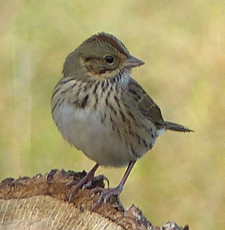
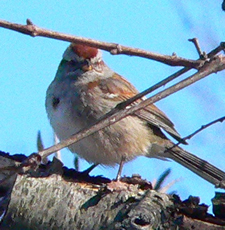
Lincoln's Sparrow American Tree Sparrow

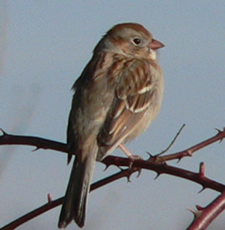
Song Sparrow Field Sparrow
Fall is in the air! It’s a wonderful time of year to enjoy the colors of the season and look for birds migrating through our parks. October and November are prime months for sparrow migration. Sparrows are a group of birds that are so similar in color and general appearance that many just refer to them as “LBJs” or Little Brown Jobs. About 30 species have been seen in New Jersey.
Some such as the white-throated sparrow and dark-eyed junco will winter here and others that have been here all summer such as the Chipping Sparrow will leave and head south. Still others such as the song sparrow, swamp sparrow and the field sparrow can be seen in New Jersey year round. Sparrows are primarily ground nesters and seed eaters. These LBJs can be seen traveling in large mixed flocks through most of our parks this month.
Our local sparrows are considered New World Sparrows, family Emberizidae, and are not in the family Passeridae, the true sparrows or Old World Sparrows. New World Sparrows are considered short distance migrants traveling only to the southern part of the US, Mexico and rarely into Central America. Posted 10/14/14
Praying Mantis at Huber Woods Park
 Praying Mantis
Praying MantisThe praying mantis is one of our more fascinating insects. There are about 20 species that are native to North America and several exotic species that have been deliberately introduced. All mantises are carnivorous and have a voracious appetite, feeding almost continuously throughout the day. Mantises feed on insects, frogs, snakes, lizards and will even eat other praying mantises. Many gardeners consider these eating machines to be highly beneficial. However, the mantises do not discriminate and will eat beneficial insects as well as those considered pests. A hungry female mantis may devour the male after mating. The cautious male mantis will seek out a well fed female for courtship and often escape the encounter.
The praying mantis population status is stable throughout its range and it does not appear on any threatened or endangered species lists in the U.S. In autumn, eggs numbering from 10 to 400, depending on the species, are deposited in a foamy secretion that will harden, forming a protective case. In the spring, the young will emerge as nymphs looking similar to the adult without wings. The young grow rapidly throughout the summer, molting several times. The life span of a wild mantis in temperate climates is about 12 months and in captivity about 14 months. Praying mantises are prey for bats, birds, lizards, snakes and other insects. Posted 10/08/14
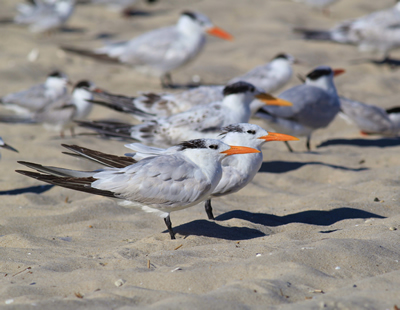
Recently, a flock of gull-like birds with orange bills were spotted along the edge of Sandy Hook Bay at the Bayshore Waterfront Park. The birds were Royal Terns that have come north from their breeding sites in southern New Jersey or perhaps in Chincoteague, Virginia or even as far south as North Carolina to rest and forage for small fish, including spearing and bay anchovies. Soon, the birds will be off again to migrate south for the winter in Florida. A group of royal terns are collectively known as a "highness" of terns, so it appeared for at least for a day that royalty visited the park. Posted 9/26/2014
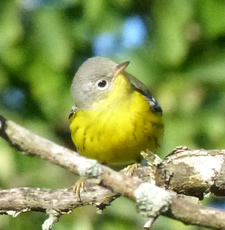
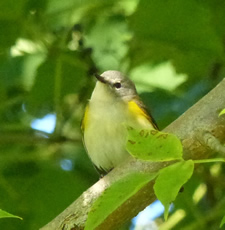
Magnolia Warbler American Restart
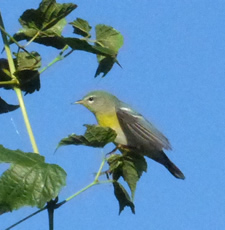

Northern Parula Red-eyed Vireo
Fall migration is well under way in our area and can be a real treat for the observant park patron. Many songbirds can be seen as they work their way south to their wintering grounds. Wood Warblers are an especially colorful group of small birds that are currently traveling through Monmouth County and other parts of the country. There are approximately 40 species that may be seen in NJ during spring and fall migrations. Traveling with these flights of migrating warblers will be vireos, orioles, kinglets, and gnatcatchers. The birds pictured here were seen at Huber Woods Park this week all feeding and traveling together. All one needs is a keen eye and a pair of binoculars to enjoy these beautiful birds as they move through our area over the next several weeks. A bird identification book could also come in handy. Posted 09/24/14
Read more about fall bird migration in our Fall issue of the Green Heritage.
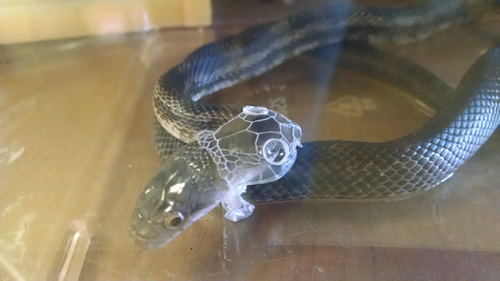
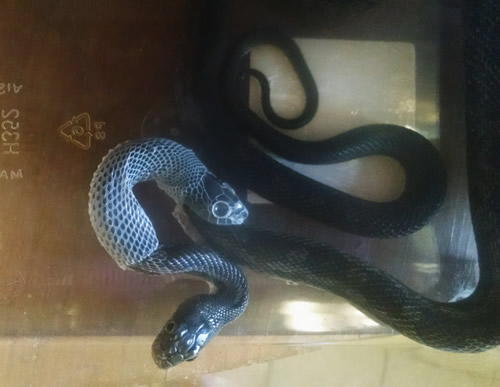
At first glance these pictures may appear to be a two-headed snake. A closer inspection reveals that this snake is in the process of shedding its skin or ecdysis. This young Black Rat snake resides at the Huber Woods Reptile House. Our animal care technician was able to take this unusual photograph. Shedding is a natural process associated with growth and can be influenced by health, age, nutrition, ambient temperature and humidity. Adult snakes may shed once every 4 to 6 weeks and young snakes may shed a few times a month. A healthy snake will usually shed its skin in one piece. A shed that results in sloughing pieces of the skin could be an indicator of poor health, improper lighting, poor humidity or low ambient temperatures. Posted 09/24/14
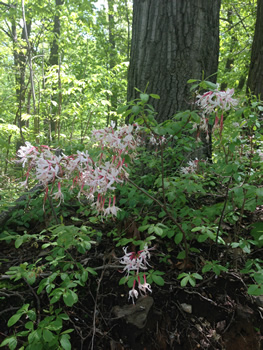
The delicate pink flowers of the wild Pinxter Bloom Azalea can be seen both trailside and roadside in Huber Woods Park. These particular shrubs were spotted through shady, dappled sunlight along Brown’s Dock Rd.--an ideal growing condition for this type of plant. While they used to be classified separately, today azaleas are classified as rhododendrons, but the word azalea persists in garden use and custom. Can you see why that might be? Posted 06/09/2014
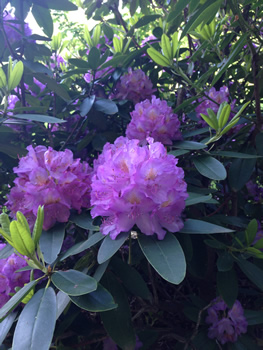
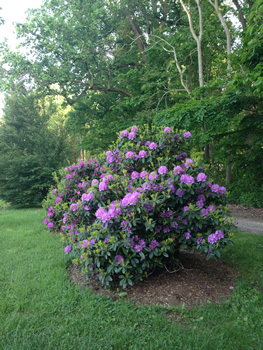
The Rhododendron is having an exceptionally lovely season this year. Just check out this specimen, located along the Service Road just past the Production Greenhouses at Deep Cut Gardens. The whole shrub is covered with large, bright purple blooms. Posted 06/09/2014
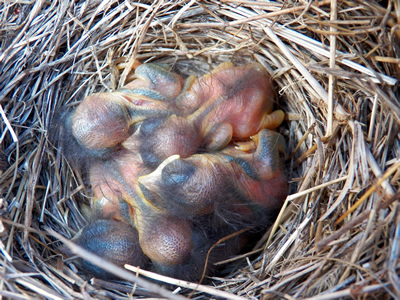
This photo was taken by our volunteer Mary Jane Davis, a Bluebird house monitor at Dorbrook Recreation Area. Ms. Davis is a teacher at Red Bank Catholic High School whose students built and installed the bird houses.
The Bluebird Boxes at Dorbrook Recreation Area are proving successful again this year. These five recently hatched chicks seem quite comfortable in their well kept house. While some Bluebirds will migrate south during the winter months, many are year round residents in Monmouth County. Although primarily insectivores during the spring and summer, Bluebirds will eat berries and small seeds during the fall and winter when insects are in short supply. Bluebirds will pair up in the spring and may produce 2 or 3 clutches each year. The clutches can have 2 to 7 chicks. In the winter, Bluebirds will band together in small flocks and have been known to use the nesting boxes for shelter. As many as 12 birds have been found cuddling in a nesting box on a cold winter’s day. Posted 05/18/14
Jack-in-the-Pulpit (Arisaema triphullum) in Holmdel Park
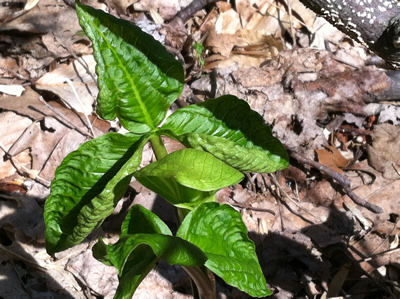
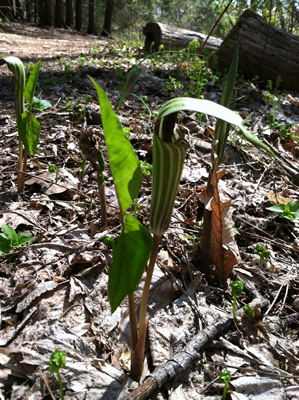
Along a stream trail in Holmdel Park, one of our Park System Naturalists came upon a growth of Jack-in-the-Pulpits (Arisaema triphullum). These plants get their name from the plant parts that surround the flowers. Easily confused with being a flower, the spathe is greenish yellow to green and is tube shaped and curved over the top like a hood. On the inside there are often black stripes. Inside the spathe (“Pulpit”) is the spadex (“Jack”), the part that the flowers grow on. Both male and female flowers occur on the same plant, the male flowers blooming earlier than the female flowers. In late summer, the flowers become bright red berries. The plant has one to two leaves that surround the Jack-in-the-Pulpit. Each leaf has three leaflets and can be from 1-3 feet in height. All parts of this plant are poisonous if ingested, but an interesting find on a nature walk. Posted 4/30/2014
Redback Salamander (Plethodon cinereus) at Huber Woods Park
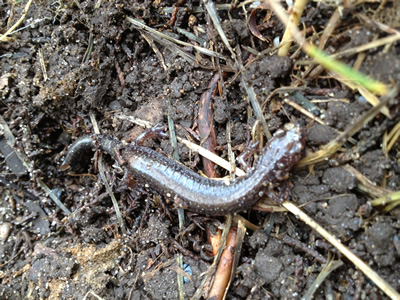
The Redback Salamander (Red-backed or Red Back) is a native, hardy and small terrestrial salamander. This species lives under rocks, leaf litter and rotten logs in forests. They are common in forest habitats and abundant beneath old logs, bark, moss, leaf mold and stones in evergreen, mixed and deciduous forests. This animal is nocturnal and feeds on invertebrate insects, such as ants, collembolan (springtails), mites and termites. The Redback lacks lungs; it breathes through its skin and does not need to be in the water to lay its eggs. Posted 4/22/2014
Two Eaglets at the Manasquan Reservoir
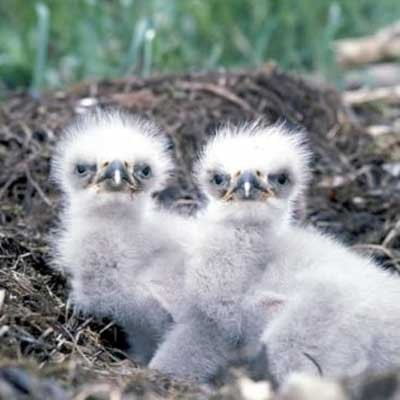
Photo of another pair of eaglets, courtesy of US Fish and Wildlife
We are happy to announce there are two eaglets in the Bald Eagle nest at the Manasquan Reservoir in Howell. Over the next few weeks, these eaglets will change quickly. By six weeks they grow to nearly the size of their parents and their grey down will become black feathers. At 10 to 13 weeks (approximately May), they will take their first flights.
Interested in learning more about the eagles and their history at the Manasquan Reservoir? On Sunday, April 13 at 10:00 am we are offering Bald Eagles at the Manasquan Reservoir (#I0942A). Online registration is available by clicking on the title of the program.
The eagle family can be easily viewed from the Manasquan Reservoir Environmental Center. Please remember, nesting eagles are very sensitive and could easily abandon a nest if disturbed. Respect all protected areas. Posted 3/21/2014
*******************

Beautiful crocuses are beginning to pop up in the meadows of Huber Woods Park. Early to late spring, as well as during the fall, is the best time to view these delicate flowers in our area. Crocuses come in a variety of beautiful colors such as blue, white and yellow. They are native to North America and Europe and grow in meadows, scrubs and woodlands between a wide range of elevations, from sea level to alpine tops. Posted 3/17/14
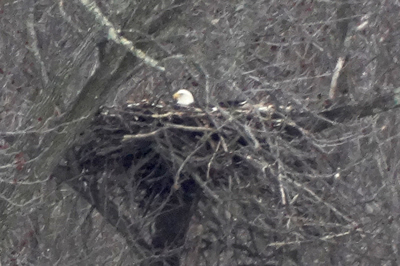
Photo by Aubrey Merrill
During the last week of February, egg hatching began in the Manasquan Reservoir Bald eagle’s nest. At present, we can’t see the chicks because they are too small. How do we know hatching occurred? It’s all about changes in the parent’s behavior. We observed the sitting adult moving around more, sitting higher in the nest, looking down often, and most importantly we observed feeding behaviors. The next big question is how many eaglets are there? We will have to wait and see. It will take another week or two before they are big enough to be seen easily.
The nest can be viewed from the Manasquan Reservoir Environmental Center. The Environmental Center hours are 10am-4:30pm, daily. If you view the nest outside, remember nesting eagles are very sensitive to human disturbance and could easily abandon a nest if disturbed. Please respect all protected areas. Posted 3/5/14
*********************
Full Moon Over Sandy Hook Bay
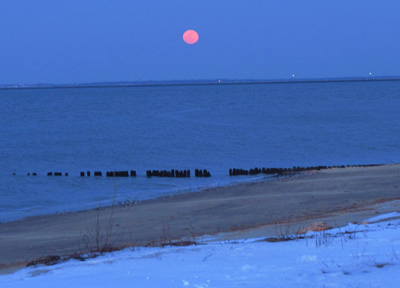
Last Friday, several people joined a Park System Naturalist for a full moon beach walk along Sandy Hook Bay at Bayshore Waterfront Park. It was Valentine’s Day and a beautiful evening to watch the moon rise over the bay. Winds were light, the sky was clear, and temperatures were relatively balmy in the lower 30s. It was a full “snow” moon, named by many prehistoric Native American people in the Northeast, since some of the heaviest snowstorms took place during this time of year.
If you missed this nighttime walk, please join us for Full Moon Meander (#INF42A) on Saturday, March 15th at Mt. Mitchll Scenic Overlook or Stargazing at the Seashore (#INP42A) on Saturday, April 26 at the Bayshore Waterfront Park. Online registration is available by clicking on the title of each program. Posted 2/18/2014
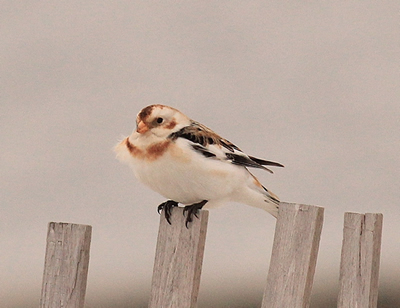
Recently, a small flock of about six to eight Snow Buntings have been showing up every morning near Sandy Hook Bay at the Bayshore Waterfront Park. The small birds have arrived from the high Arctic, where they have nested and raised 2 to 7 young during the summer. In the winter many Snow Buntings can be found around the bay resting and feeding on plant and grass seeds. The birds are getting ready for another long migration and busy breeding season up in the tundra starting in the spring. Posted 1/31/2014
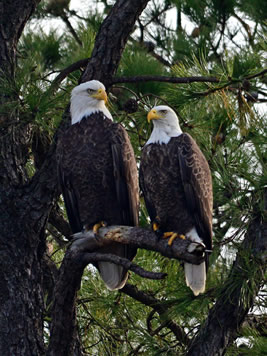
These are exciting times at the Manasquan Reservoir! On January 21, our resident Bald Eagle pair began incubation. From now until hatching, one of the adults will almost always be seen on the nest. Eagles begin sitting immediately upon laying their first egg, but may produce up to two more eggs over the next few days. If more than one egg is produced, the eaglets will hatch in the order they were laid over several days. Generally, incubation requires about 35 days. This makes the approximate date of hatching during the week of February 24. The eagles' nest can be viewed from the Manasquan Reservoir Environmental Center, weather conditions permitting.
Posted 1/27/14
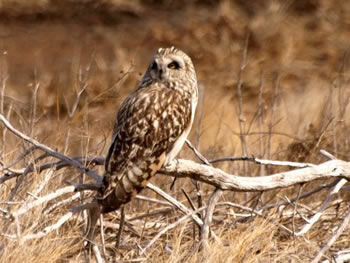
Photo by park patron Jeff Lee
A Park Ranger recently discovered two Short-eared Owls hunting the open fields at Wolf Hill Recreation Area on Christmas Day. These Owls are regular winter visitors to New Jersey and are occasionally seen in Monmouth County. Short-eared Owls have a mottled brown appearance, are about 17 inches tall, weigh 7 to 16 ounces, and have a wing span of 25 to 40 inches. These grassland birds feed mainly on small mammals and may compete with the Barn Owl where their ranges over lap. They hunt during the day as well as at night. These Owls have a distinctive hunting technique, floating low over meadows and fields then diving on their prey. Their nests are mainly on the ground and their clutch can range from 1 to 11 eggs. Short-eared Owls are one the most widely distributed Owls in the word ranging across North America, South America, and Eurasia as well as many oceanic islands. Posted 01/03/14

One of our Park Rangers spotted a couple of Snowy Owls at Seven Presidents Oceanfront Park over the past several weeks. New Jersey is experiencing an unprecedented incursion of Snowy Owls this winter with more than 30 individuals reported along our shores. These beautiful birds stand about 28 inches tall, weigh around 4 to 5 pounds and have a 50 inch wing span. These are diurnal owls on their home range, the Arctic Tundra, where they feed on many small mammals but mainly on lemmings. They will also take small birds. The normal clutch size is usually between 3 to 4 but may be as many as 11 eggs. The adult males are almost all white while the adult females will be white with brown barring. Juvenile male and females will both exhibit the brown barring and can be difficult to distinguish. Posted 01/02/2014
Back to Nature Now